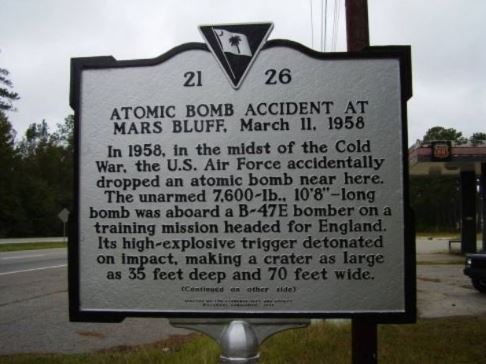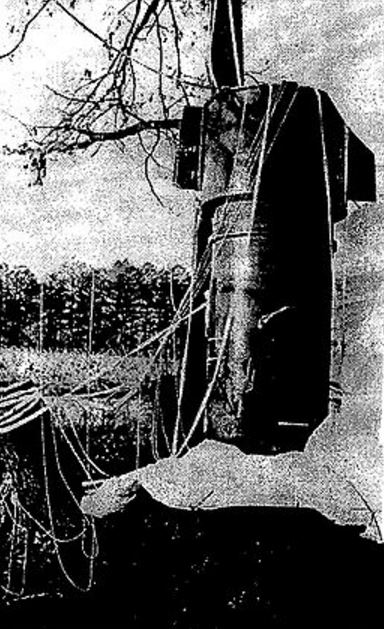It looks like you're using an Ad Blocker.
Please white-list or disable AboveTopSecret.com in your ad-blocking tool.
Thank you.
Some features of ATS will be disabled while you continue to use an ad-blocker.
6
share:
Two interesting tales I had never heard of before, regarding the loss of nuclear weapons over North and South Carolina. Fortunately these incidents
barely made a mark, but it could have been much worse.
March 11, 1958, South Carolina
In 1958, the US Air-force accidentally dropped a nuclear weapon on a girl's playhouse.
On March 11, 1958 an American B-47E bomber flying over Florence, South Carolina, on its way to England had some problems with their Mark 6 fission bomb. The captain had some problems with the locking pin of the bomb, and he went into the plane's bomb bay to inspect the device.
io9.gizmodo.com...

Lucky for the Captain, the bomb's nuclear core had been stored elsewhere on the aircraft, but the bomb was still detonated, just without nuclear fission.
The only casualty of this incident was the girl's dollhouse, and 6 people were slightly injured.
Today, a plaque marks the spot where the bomb was detonated

23 January 1961, North Carolina
The incident over North Carolina was potentially much worse, with the loss of bombs 260 times more powerful than the device which destroyed Hiroshima. Shortly after takeoff from Seymour Johnson AFB, a B 52 bomber broke apart in mid air.
This incident was potentially a lot more serious than the 1958 incident.
www.theguardian.com...
That's right, only one switch prevented a huge potential carnage. It seems there were 6 switches, and 5 were released.
restorationsystems.com...

Despite the claims of the US government that American lives have ever been put in jeopardy, the report claims otherwise.
One of the bombs broke into several pieces, losing its uranium component, and it is believed this piece may still be buried in the swampy area the bomb fell. For any intrepid uranium hunters, the Air Force has purchased these lands, so it is pretty much off bounds.
Quite frightening to thing what might have been, and an indication of just how close the U.S has been to having had a nuclear bomb detonated over heavily populated areas.
March 11, 1958, South Carolina
In 1958, the US Air-force accidentally dropped a nuclear weapon on a girl's playhouse.
On March 11, 1958 an American B-47E bomber flying over Florence, South Carolina, on its way to England had some problems with their Mark 6 fission bomb. The captain had some problems with the locking pin of the bomb, and he went into the plane's bomb bay to inspect the device.
io9.gizmodo.com...

Kulka had no idea where to find the locking pin in the large and complicated bomb-release mechanism. After a tense 12 minutes searching for the pin, the bombardier decided, correctly, that it must be high up in the bomb bay and invisible because of the curvature of the bomb. A short man, he jumped to pull himself up to get a look at where he thought the locking pin should be. Unfortunately, he evidently chose the emergency bomb-release mechanism for his handhold. The weapon dropped from its shackle and rested momentarily on the closed bomb-bay doors with Captain Kulka splayed across it in the manner of Slim Pickens in Dr. Strangelove. Kulka grabbed at a bag that had providentially been stored in the bomb bay, while the more-than-three-ton bomb broke open the bomb-bay doors and fell earthward. The bag Kulka was holding came loose, and he found himself sliding after the bomb without his parachute. He managed to grab something-he wasn't sure what-and haul himself to safety.
Moments later the plane was rocked by the shock wave of the blast when the bomb hit the ground.
Lucky for the Captain, the bomb's nuclear core had been stored elsewhere on the aircraft, but the bomb was still detonated, just without nuclear fission.
The only casualty of this incident was the girl's dollhouse, and 6 people were slightly injured.
Today, a plaque marks the spot where the bomb was detonated

23 January 1961, North Carolina
The incident over North Carolina was potentially much worse, with the loss of bombs 260 times more powerful than the device which destroyed Hiroshima. Shortly after takeoff from Seymour Johnson AFB, a B 52 bomber broke apart in mid air.
This incident was potentially a lot more serious than the 1958 incident.
www.theguardian.com...
The bombs fell to earth after a B-52 bomber broke up in mid-air, and one of the devices behaved precisely as a nuclear weapon was designed to behave in warfare: its parachute opened, its trigger mechanisms engaged, and only one low-voltage switch prevented untold carnage.
Each bomb carried a payload of 4 megatons – the equivalent of 4 million tons of TNT explosive. Had the device detonated, lethal fallout could have been deposited over Washington, Baltimore, Philadelphia and as far north as New York city – putting millions of lives at risk.
That's right, only one switch prevented a huge potential carnage. It seems there were 6 switches, and 5 were released.
restorationsystems.com...

Lapp wrote in Kill and Overkill that each device involved in the Goldsboro incident was equipped with “six interlocking safety mechanisms, all of which had to be triggered in sequence to explode the bomb.” Lapp said that “five of the six interlocks had been set off by the fall…” and thus, “only a single switch prevented the bomb from detonating and spreading fire and destruction over a wide area.”
Despite the claims of the US government that American lives have ever been put in jeopardy, the report claims otherwise.
But in the newly-published document, a senior engineer in the Sandia national laboratories responsible for the mechanical safety of nuclear weapons concludes that "one simple, dynamo-technology, low voltage switch stood between the United States and a major catastrophe".
"The US government has consistently tried to withhold information from the American people in order to prevent questions being asked about our nuclear weapons policy," he said. "We were told there was no possibility of these weapons accidentally detonating, yet here's one that very nearly did."
One of the bombs broke into several pieces, losing its uranium component, and it is believed this piece may still be buried in the swampy area the bomb fell. For any intrepid uranium hunters, the Air Force has purchased these lands, so it is pretty much off bounds.
Quite frightening to thing what might have been, and an indication of just how close the U.S has been to having had a nuclear bomb detonated over heavily populated areas.
edit on 24-1-2017 by cuckooold because: (no reason given)
Thanks for posting this!
It's a little before my time and I'd never heard anything about it. Will be the first to say it's shocking some of the American history I'm ignorant of, so posts like this are great reading now. Followed the link in your story about the first accidentally dropped bomb on the Gregg's family property and it had more recent pictures and additional information.
It's a little before my time and I'd never heard anything about it. Will be the first to say it's shocking some of the American history I'm ignorant of, so posts like this are great reading now. Followed the link in your story about the first accidentally dropped bomb on the Gregg's family property and it had more recent pictures and additional information.
Saw a list about Nuclear accidents from the 50's till present day , i was quite impresed with the amount of accidents.
almost a miracle there have not been any serious detonations.
almost a miracle there have not been any serious detonations.
edit on 24-1-2017 by TheGreazel because: (no reason given)
a reply to: TheGreazel
legend has it that there has been at least one accidental nuclear detonation, just not in the US.
legend has it that there has been at least one accidental nuclear detonation, just not in the US.
a reply to: cuckooold
There are many safety features built into US nuclear devices. Just falling out of the bomb bay doors would not have resulted in a nuclear event. It may have resulted in nuclear material being blown about the area, but not a nuclear detonation.
There was another in Georgia, Pennsylvania, one off the coast of N.C I think (that still hasn't been recovered), Thule Greenland. There was the Trident II explosion. (They found the Pit like a mile down the road)
That one in your OP in N.C. was the closest call. But that's the point of all the built in safeties. They worked as designed.
There are many safety features built into US nuclear devices. Just falling out of the bomb bay doors would not have resulted in a nuclear event. It may have resulted in nuclear material being blown about the area, but not a nuclear detonation.
There was another in Georgia, Pennsylvania, one off the coast of N.C I think (that still hasn't been recovered), Thule Greenland. There was the Trident II explosion. (They found the Pit like a mile down the road)
That one in your OP in N.C. was the closest call. But that's the point of all the built in safeties. They worked as designed.
My dad was in the Air Force in the 50's. He used to tell a story about how he and his crew almost bombed Las Vegas, but realized it at the last
second. Navigator Error. He was the navigator! He did a lot of the testing runs in the desert back then. He had some funny stories!
He died in 2012 of End Stage Parkinsons. As there isn't any history of it in my family, we always wondered if it was caused by radiation, somehow. 😕
He died in 2012 of End Stage Parkinsons. As there isn't any history of it in my family, we always wondered if it was caused by radiation, somehow. 😕
new topics
-
The truth lets admit it
Aliens and UFOs: 2 hours ago -
Mass Shooting Towson, Maryland - 7 shot, 1 possibly dead
Social Issues and Civil Unrest: 5 hours ago -
Trump formally clinches Electoral College victory
2024 Elections: 10 hours ago
top topics
-
Trump formally clinches Electoral College victory
2024 Elections: 10 hours ago, 17 flags -
Was Biden's Mass clemency and pardons one last cash grab?
US Political Madness: 14 hours ago, 10 flags -
What's the buzz
General Chit Chat: 14 hours ago, 8 flags -
Mass Shooting Towson, Maryland - 7 shot, 1 possibly dead
Social Issues and Civil Unrest: 5 hours ago, 5 flags -
Elon Musk has Meeting with Nigel Farage at Mar-a-Lago
Regional Politics: 14 hours ago, 4 flags -
The truth lets admit it
Aliens and UFOs: 2 hours ago, 3 flags
6
